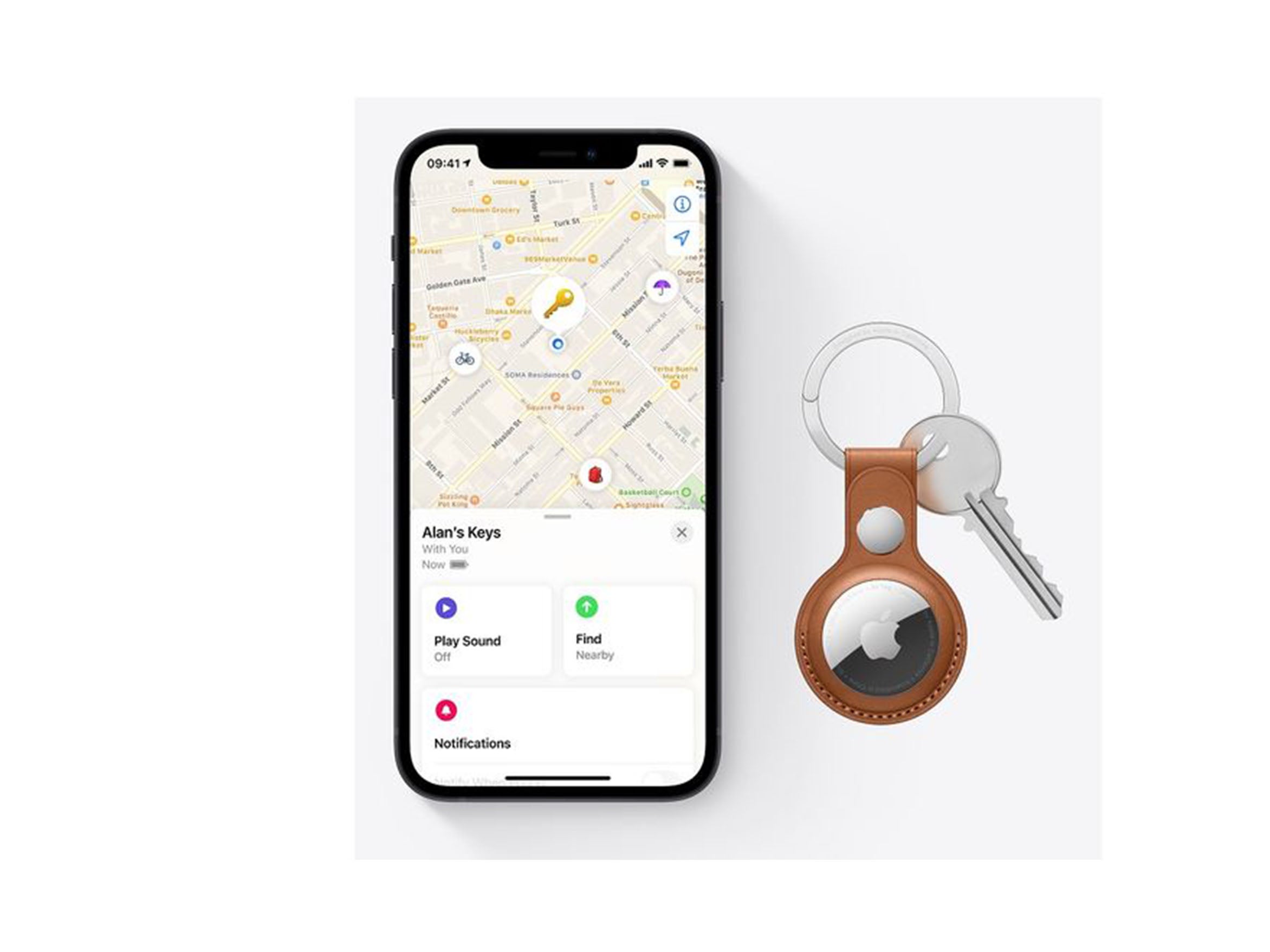Apple AirTag

The biggest shock for us during the Apple event wasn’t that the company had finally announced the AirTag after such a long time. No, it was simply how uncharacteristically cheap these little things are.
A single AirTag costs just £29, and a pack of four costs £99. The Tile mate (£19.99, Amazon.co.uk) and the Tile pro (£29.99, Currys.co.uk) aren’t that far away in terms of price.
The Apple AirTag has been available since 30 April.
DesignThe first thing you’ll notice when you open up the box is simply how tiny the Apple AirTag is. It looks like a little 32mm button badge of the kind that school kids used to attach to their Nike backpacks to look cool. Except it’s shiny, and a little weightier.
It’s 8mm thick and weighs 11g. The stainless steel disc has the Apple logo embossed on top of it and it sits in a trademark white plastic cover. Inside the cover is a removable CR2032 battery, estimated to last a year. Apple says you’ll get a notification when the battery is about to die, and you can always look at how much battery is left in the Find My app.
Set up was a doddle. Once we’d removed the film protecting the AirTag, we heard a little tone (eerily similar to the Black Mirror ringtone) indicating that it was ready to pair. Once we brought it close to our iPhone 12 Pro, the familiar pop-up box you see when you connect your AirPods to your iPhone for the first time appears. You can then give your AirTag a name, designate an emoji and track it in the Find My app.
Read more: Fitbit Versa 3 vs Fitbit Sense – which fitness smartwatch is best?
The AirTag is waterproof with an IP67 rating, meaning they can be dunked in a metre of water and survive for up to 30 minutes.
One of the big drawbacks of the AirTag is that while it’s roughly the same price as its competition, Tiles have keyring holes and AirTags do not. If you want to attach your AirTag to your keys or your AirPods, you’re going to need to buy a separate accessory to put your AirTag in – something that will boost the price considerably. An Apple-made leather keyring (£35, Apple.com) and a leather loop (£39, Apple.com) are both more expensive than the AirTag itself.
That said, there are already dozens of cheaper third-party AirTag accessories floating around online right now. Belkin’s keyring loop (£11.95, Apple.com) is also available from Apple and is much more affordable. Then there are other AirTag holders, like ESR’s two-pack of AirTag keychains (£8.79, Esgear.com) and a three-pack of silicone keychains by D-Rings (£4.87, Amazon.co.uk). We will be rustling up a list of our favourite AirTag accessories imminently, so check back soon. Many of the bigger brands are still working on theirs.
How does it work?Once you’re all set up and have your AirTag attached to every item under the sun, it’s ridiculously easy to track them. If it’s in Bluetooth range, asking Siri where the item is will force the AirTag to chirp. You can also get it to make a sound through the Find My app, which is where the most interesting feature of the AirTag comes into play.
Inside the Find My app is a map that shows the AirTag’s current location or – if you’ve dropped it somewhere remote where there aren’t many other iPhones around – the last known location when it was in range of your iPhone. Just like Tile, there’s no GPS in these little item finders, but what it does have, no company can beat.
AirTags use Apple’s enormous network of devices connected to Find My to help locate your item, something that Apple says is nearing a billion devices globally. If you lose it inside a shopping centre, chances are you’ll be able to track it to its address. iPhones will keep pinging it as people walk by, and all your location data is encrypted and anonymised.
Read more: Why you should use a VPN
Beneath the map is a “find” button which will help you locate the AirTag using a feature called precision finding. It’s all thanks to the ultra-wideband U1 chip embedded inside the new iPhones. The AirTag doesn’t just rely on Bluetooth to help track down your lost items – ultra-wideband will help direct you toward it. You’ll get handy arrows telling you which direction to turn in and how far away the AirTag is from your current location.
You can also put the AirTag into lost mode, which will give you a notification if the AirTag is on the move. When you enable lost mode, you’ll be asked to add your contact details to the AirTag, so if someone stumbles upon it and taps any NFC-compatible smartphone to the AirTag, your contact details will pop up on their screen. They can either contact you or deactivate the AirTag completely.
How good is it really?To put the AirTag through its paces, we tested it inside our home and on a trip into the real world. The first thing to note is that while the precision finding feature is pretty neat, it isn’t always reliable.
Exhibit A: tucking the AirTag behind some cushions in the living room. We live in a third-floor flat, and we just couldn’t get a signal when we entered Find mode. After a minute of walking up and down, pointing our phone up in the air like we were in a Noughties sitcom, the arrow finally appeared. Once a signal was established, finding the AirTag worked seamlessly, giving us nice little haptic prompts as we got closer and closer to its location.
You can also make the AirTag chirp in the Find My app, although we found this slightly awkward because it only gives about three chirps before going silent again. Tile, on the other hand, will chirp constantly until you turn it off. We assume this is a measure to help preserve the battery life of the AirTag. The speaker inside is also slightly quieter than we’d like and is definitely noticeably quieter than the one in the Tile Mate. It’s still loud enough to be heard, however.
Read more: Which laptop should I buy? Here’s our guide
We gave our registered AirTags to a couple of family members while they were outside to test how well we could track them when the device wasn’t in our possession. We wanted to simulate what it would be like if we genuinely did lose our stuff.
One of our family members took the AirTag to the park, sat on a bench and informed us that we could now start tracking it. We put it into lost mode and saw exactly which park the AirTag was in, as well as its general location. Both precision finding and the sound indicator didn’t work until we got about 10 metres in range of the AirTag, so we reckon it will be harder to find in more built-up environments like shopping centres and in locations where there is more than one floor in a building.
When our family member tapped their own iPhone against the AirTag, it brought up our contact details pretty seamlessly. In the words of Tim Cook, it just works.
What about privacy?Something that Apple took great lengths to explain during the Apple event last month were the privacy features that would help to discourage AirTag owners from placing it in people’s bags and tracking their whereabouts surreptitiously. Apple says that the AirTag will sound an alert if it’s been apart from its owner for a set period of time and anyone with an AirTag on them will get a notification telling them so.
Most of my family had yet to update to iOS 14.5, which is needed to provide the notification alerts. But once they updated, they didn’t start getting notifications until the tags had been in their possession for a few hours. It’s unclear when these notifications will appear, but Apple says that the person being tracked should get pinged when they return home. For Android users, the notification will appear even later. According to Apple, it’s a whole three days before Android users will be alerted to the surreptitious AirTag.
The verdictThe AirTag is incredibly cheap for what it is, and it works like an absolute charm. For any iPhone owner prone to losing things, investing in a pack of four might be one of the best decisions you ever make. Precision tracking works wonderfully well when you can get a signal, and the fact it’s powered by removable batteries is a real bonus in our eyes.
Ultimately, as with many things Find My, there’s strength in numbers. There are just so many devices connected to the Find My network that you’ll always be able to locate your AirTag if it goes awol. Just be prepared to splash out a little more on the accessories if you want to attach it to your keys.

